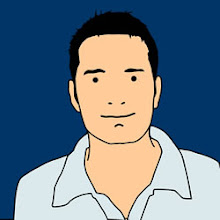I thought my answers might be of interest to anyone looking to get in to Motion Graphics, so decided to post them here (these are in no particular order, and are by no means an exhaustive list)...
(NOTE: These aren't all essential skills for somebody starting in motion graphics design, just things which have been useful to me over the years, whether they were existing skills or things that I picked up along the way. )
- Graphic Design Skills - I often decribe my job as being a 'graphic designer who makes things move'! It is essential to understand things like the difference between vector and bitmap (or raster) graphics, and the difference between CMYK and RGB. A basic knowledge of software such as Illustrator and Photoshop goes a long way. Understanding the basics of typography, colour and layout are also very important.
- Understanding of how television/video works - it's very useful to understand things like frame rate, the differences between formats such as PAL and NTSC (and now HD formats), TV-safe margins, Broadcast colours etc - if you don't have this knowledge before you start, it should be one of the first things that you learn.
- Observation of the world around you - particularly the way things move in the real world. Also, the 'imperfections' of the world, for example dirt and grime on objects, and the variation in nature.
- Understanding of how light works - how white light is made up from Red, Green and Blue components, the way those colours mix and how light interacts with different surfaces.
- Attention to detail - this is a key difference between an OK designer and a great designer! Humans are subconsciously very sensitive to how things appear - when you're trying to simulate reality it's the small details that will really make it convincing.
- Understanding of 3D - knowing how X, Y and Z positioning and rotation work
- Musical Knowledge -synchronising motion and events to music is an essential part of being a motion graphics designer. It's really helpful to have an understanding of how music is structured and an ear for the subtle nuances in music which can act as cues for motion. If you're a freelancer or work for a small company you can often find yourself needing to edit pieces of music to fit a particular purpose - understanding how beats and bars work is essential in this situation.
- Mathematics / Computer Programming - Motion Graphics software such as After Effects allows you to control parameters mathematically using 'expressions' which can be a huge timesaver if you know how to use it. As a simple example, you could create a wave motion by using a Sine curve to control position, rather than having to create dozens of keyframes.
- Thirst for knowledge / research skills - Often it is necessary to research a subject yourself, and it's important that you can research efficiently and accurately.
- Workaholic attitude - Near-impossible deadlines go hand-in-hand with this profession, no matter which sector you work in, and working long days is a regular occurance!
- Understanding the fundamentals of computers and files - professional motion graphics software is not designed in the same way as office software like Microsoft Word where there are Wizards and Assistants popping up all over the place to help you along your way! You particularly need to understand things like file types & extensions and file sizes.

This comment has been removed by a blog administrator.
ReplyDelete